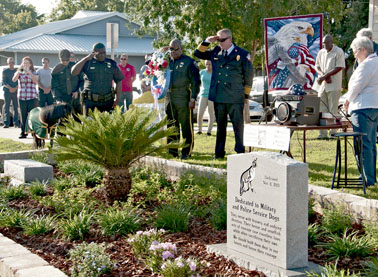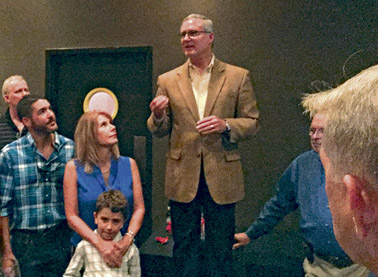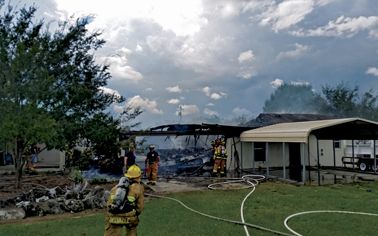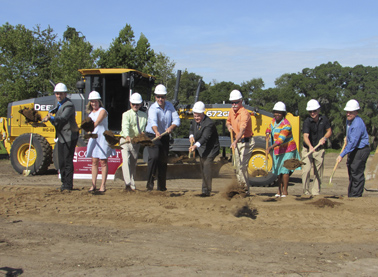 L-R: High Sjprings Police Leiutenant Antoine Sheppard, Police Chief Joel DeCoursey, Jr., and Fire Chief Bruce Gillingham salute the new memorial for 9/11 victims at t he High Sprinsg Fire House on Sept. 11, 2016. (Today Photo/RAY CARSON)
L-R: High Sjprings Police Leiutenant Antoine Sheppard, Police Chief Joel DeCoursey, Jr., and Fire Chief Bruce Gillingham salute the new memorial for 9/11 victims at t he High Sprinsg Fire House on Sept. 11, 2016. (Today Photo/RAY CARSON)
HIGH SPRINGS – The 15th year anniversary of 9-11 was marked in High Springs by the re-dedication of the 9-11 memorial and creation of a memorial garden. The memorial is located on the grounds of the High Springs Fire Department (HSFD), 18586 N.W. 238th Street.
The re-dedication ceremony began at 8:40 a.m. on Sunday, September 11, with a short address by Leda Carraro, followed by the blowing of a fire truck horn at 8:45 a.m. The blowing horn signified the time American Airlines Flight 11 crashed into floors 93-99 of the North Tower of the World Trade Center (WTC). The crash killed all 92 people on board and many more inside the tower.
Eighteen minutes later, United Airlines Flight 175 crashed into floors 75-85 of the WTC's South Tower killing 65 people on board and hundreds more inside the tower.
In addition to the deaths associated with the WTC, Flight 77 crashed into the western facade of the Pentagon in Washington, D.C., killing 59 aboard the plane and 125 military and civilian personnel inside the building.
After passengers and crew members aboard the hijacked Flight 93 learned about the attacks in New York and Washington, they mounted an attempt to retake the plane. In response, hijackers deliberately crashed the plane into a field in Somerset County, Pennsylvania, killing all 40 passengers and crew aboard.
At the ceremony, a moment of silence, coordinated via radio with the Alachua County Sheriff's Office, followed. High Springs Police Department (HSPD) Lt. Antoine Sheppard read aloud the inscription on the monument, which was followed by the placement of a wreath donated by Thompson's Flower Shop at the monument by HSFD Chief Bruce Gillingham.
HSPD Chief Joel DeCoursey, Jr., Sheppard and Gillingham did a slow salute, holding it while “Taps” were being played by Santa Fe High School student Emilee Jones. At the end of “Taps,” the salute was slowly lowered.
Mayor Byran Williams spoke followed by a prayer by Gene Levine. High Springs Community School student Kiyana Williams then sang the “National Anthem.” Gillingham and DeCoursey addressed the visitors and the ceremony ended with Kiyana Williams singing "God Bless America.”
Several people brought cut flowers to place at the memorial.
About Memorial Gardens
Noting that an enhancement of the area surrounding the memorials on the grounds would be a welcome addition to the front of the HSFD, Carrero sought and received permission from city commissioners to conduct the re-dedication ceremony and also install a garden with donations of plants and labor.
“With the generous donations from the citizens of High Springs and the donation of flowers and mulch we have created a beautiful garden surrounding the monuments,” said Carraro.
The area will be referred to as Memorial Gardens. Most of the work preparing the area was done by Harry Patterson, who also purchased at least half of the plants in the garden area. He, Carol Pratt, Sue Weller, members of the HSFD and Carrero volunteered their time to create the garden. “We are all very proud of how it turned out,” said Carraro.
# # #
Email Cwalker@
alachuatoday.com
Add a comment

 The City of Alachua's splash park is a popuar cooling off spot for area children. During hot summer months, the park is oftentimes at capacity during the weekends.
The City of Alachua's splash park is a popuar cooling off spot for area children. During hot summer months, the park is oftentimes at capacity during the weekends. 


